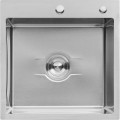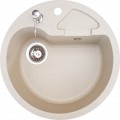Material
—
Stainless steel. The most popular material for modern kitchen sinks. «Stainless Steel» is excellent against corrosion; in addition, it is very durable and reliable, tolerates heating (you can put a hot pan), hygienic (has no pores and does not absorb contaminants) and is relatively inexpensive. The drawbacks include a high level of noise when water falls and a tendency to stains.
—
Artificial stone. Artificial stone is characterized by high strength, while being an absolutely ecological and hygienic material. It does not fade into the sun, has excellent antibacterial properties, is reliable, durable and at the same time smooth and pleasant to the touch. As a rule, the base is
granite,
quartz or
marble crumb with the addition of acrylic resin. Such sinks look attractive and have a smooth surface without pores, because of which they are not inclined to absorb odors. The surface of engineered stone is easy to clean, easy to care for.
— Granite composite. In this case, it is not natural granite, but a composite material based on granite crumb with plastic filler. Such sinks are well absorbed by the noise of falling water, excellent resistance to pollution and easy to clean, in addition have a pleasant appearance and can be performed in the most varied design (under different types and colors of st...one). But poorly tolerated by high temperatures and have a significant weight - in some models up to 50 kg. Similar manufacturing principle and dignity in sinks of marble composite, where only instead of granite chips used marble. A little different from them sinks made of quartz composite (see more. below).
— Ceramic composite. Ceramic sinks are most often made of Sanfayans or Sanfayans. The first material is more affordable, but has a porous structure, because of what tends to absorb not removed in time of contamination, and to remove them is quite difficult; Sanporcelain, in turn, is better to resist pollution, but more expensive. Common features of ceramic materials are, on the one hand, pleasant appearance, on the other - fragility and sensitivity to strong impacts (from such a blow the sink may crack). Also note that the ceramic shells are quite massive, but this moment can be considered as a disadvantage and as a virtue - a large weight reduces the probability of moving the installed product from the place, accidentally hitting.
— Quartz composite. The washing is based on technical quartz produced by sintering quartz sand and binder polymers in a proportion of 80% and 20%. Technical quartz is above all characterised by the highest strength characteristics and is almost completely immune to cracks and chipping. The surface of quartz kitchen sinks has no pores and microfractures, so it does not absorb odors and does not accumulate pathogenic microflora. Additionally, technical quartz exhibits inert properties to cleaning chemicals, vinegar and any other caustic substances. This material does not leave stains from wine and food coloring.
— Copper. Design material found mainly among sinks in the style of «retro» and other unusual design. It has a characteristic yellowish or reddish surface tone, giving the shell an unusual and stylish appearance. In terms of practical properties, this material is similar to stainless steel (see corresponding paragraph. of): in particular, it is durable, reliable and good resistance to corrosion and high temperatures. On the other hand, in the absence of obvious advantages, copper is much more expensive, and therefore it is worth paying attention to this option only if you are looking for a design model with a characteristic appearance.
— Brass. Another designer material similar to the copper described above. It has similar properties and differs only in appearance: the standard color of brass alloy is yellow. However, it is very rarely used for a number of reasons.
—Glass. In this case, the combination of glass with stainless steel (see above). Pure glass in kitchen sinks is practically not used due to fragility. Glass is usually the top of the sink (side and wing, if it is present), and of steel - the bowl itself. The glass itself is usually tinted to ensure an attractive appearance. It is worth noting that the cost of such sinks is very high, so most glass models belong to the design solutions designed for the kitchen in the original design. However, their practical characteristics are also more than decent.Material thickness
The thickness of the material used for washing.
More "thick" models, on the one hand, provide strength and reliability, on the other hand, they differ significantly in weight and cost of the product. And accordingly, for each material, its own standards in thickness are applied.
So for steel, the values start from
0.6 mm, and in the most "heavy" models, this indicator reaches a
thickness of 1.5 mm. The most common value (golden mean) is a
thickness of 0.8 mm, there are also
thicknesses of 1 mm and
kitchen sinks of 1.2 mmShape
The general shape of the sink. Note that this parameter is not indicated by the shape of the bowl, but by the shape of the product as a whole (although often these moments coincide).
In addition to the classical forms (
rectangular,
square,
>>> roundnon-standard design, which can have very unusual outlines. These sinks should pay attention to those who try to decorate the kitchen in an unusual style.
Defrost compartment
The presence in the sink of a separate container or a slight depression (a few cm) for thawing and storage of wet products. Characterized by the presence of a drain hole and predominantly compact dimensions, which makes it impossible to use
the thawing compartment as an additional bowl.
Tap hole diameter
The diameter of hole required for tap mount. This size makes it possible to understand the size of the tap to be selected, the size of the additional parts to be fitted and whether the opening for an existing faucet has to be extended or narrowed.
In box
—
Tap. The presence of a tap in the kit will eliminate the search for a suitable style. On the one hand, a tap in a set simplifies the purchase of a sink, but on the other hand, it often introduces certain restrictions. Thus, taps come in different designs and capabilities, as a result of which a complete solution may not satisfy user needs. We also note that this paragraph indicates only those taps that are officially presented in the portfolio of a particular manufacturer of kitchen sinks. Such sets can be assembled within one line or without being tied to a specific series, but purely according to style.
—
Colander. The colander supplied with the sink is usually a mesh or hole bottom tray through which water can freely pass. Such a tray can be used in the same way as a common colander - for washing cereals and ready-made pasta, for washing and drying fruit, vegetables and greenery, etc.
Cutting board. Availability of cutting board in the product delivery kit. Such a board, when used, is usually attached directly to the sink; this may be especially relevant in cramped conditions where there is not much space on the kitchen table.
—
Automatic valve. Device that facilitates filling the sink with water and draining this water. It consists of the valve itself, which closes the drain opening, and an exit button or lever
..., which is installed in a convenient place - for example, near the mixer. To drain water, it is enough to press a button or lever, opening the valve - it is much more convenient and comfortable than to lower your hand in the water and reach the drain hole.
— Mesh on bowl. Mesh made of durable wire mounted over the bowl; can be made removable or foldable. This device is mainly used as a dishwasher; it can be especially useful if the kitchen does not have space for a separate dryer, or if you periodically have to deal with a large number of dishes for which a separate dryer is no longer enough.
— Detergent dispenser. Availability of a dispenser for liquid detergents. This device looks like a container with a characteristic cap and a long spout: when you press the cap, a portion of the contents is delivered through this spout. The size of each portion is very small - by pressing the required number of times, you can quite accurately dose the amount of detergent. Dispensers of this design save space in the kitchen, since most of their body is located under the sink. This affects not only the ease of use of detergents, but also the aesthetic design of the kitchen interior.
— Siphon. The presence of a siphon supply kit is a characteristic curved tube for connecting a sink drain to a sewer. The complete siphon is by definition optimally compatible with the «native» wash; it saves you the hassle of searching and selecting.Surface type
Type of washing surface made of stainless steel (cf. «Body material»).
— Glossy. Brilliant, mirror surface, distinguished by attractive appearance. On the other hand, on such a surface quickly appear contamination and mechanical damage (traces from dried water, fingerprints, scratches, etc.), so to preserve the appearance it needs to be cleaned regularly, or even polished.
— Matte. The matte surface does not look as bright as glossy - it is fainter, without pronounced reflections. On the other hand, such surfaces are less susceptible to contamination and damage: fingerprints, traces of dried water, scratches and scuffs on such surfaces are not as visible as on gloss.
— Textured. Surface having a relief pattern with a depth of a fraction of a millimeter. This material is most convenient and practical from the point of view of maintenance, it perfectly masks contamination and is well resistant to scratches. The main drawback of textured surfaces is higher cost than matt and glossy. In addition, contamination and bacteria can accumulate in grooves, so clean such sinks should be with special care.
Country of origin
There are many national stereotypes: some countries seem more attractive to many users than others. However, in our time these stereotypes are practically grounded. First, in the country of origin of the brand, often only the headquarters of the manufacturer, and the production may be located in another State. Second, the origin from a certain country is not a guarantee of quality: everything depends on how carefully a manufacturer controls its products. Therefore, to assess the quality should be guided not by «nationality», but primarily by the reputation of a particular brand and price category of the product. Among the countries represented are:
Germany,
Italy,
Poland,
Romania,
Serbia,
list", > 3653/href/list."/list/53/pr-36269/">Switzerland, Japan.Manufacturer's warranty
The warranty period declared by the manufacturer for this model is the period during which the manufacturer guarantees normal operation. The specific terms of the warranty may vary, however, as a rule, it covers factory defects and malfunctions caused by the fault of the manufacturer/seller and discovered during normal use, without violating the rules.
The longer the warranty period (mostly there are models with a guarantee for
5 years,
10 years, 15 years or even
with a lifetime warranty) - the more reliable the sink is, the higher its overall quality, all other things being equal, but the more expensive it will cost in comparison with analogues.
However, depending on the market (country in which it is sold), the warranty for the model may differ. For example, for the countries of the European Union, America and other advanced states, the guarantee can be increased.

